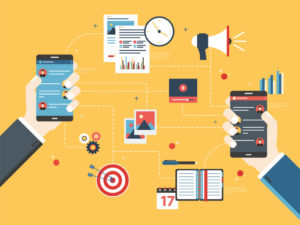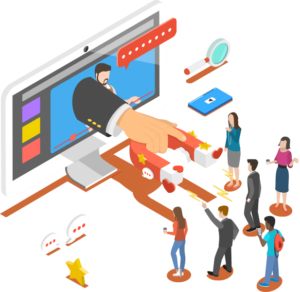It’s no surprise that video has taken the digital ad space by storm. It’s rare that you scroll your newsfeed or surf the web without being served an ad that is relevant to your specific interests. In 2019, 87% of marketing professionals were leveraging video in their media strategies and more than 80% of video marketers saw a stronger ROI than when they ran static banner ads or paid social image ads.
So, why are video ads so popular? And why should marketers continue to invest in video advertising in 2020?
Expanded Inventory
For starters, video inventory is incredibly robust. You can reach users across a variety of different platforms and sites – from social platforms to Connected TV devices. That’s right, you can now tailor ads to reach users while they’re streaming a show through their smart TVs. Marketers can also place video pre-roll ads across premium website inventory, along with video-specific platforms like YouTube, where ads play before or during video content that a user is viewing.
Video ad inventory has expanded across social platforms in the past few years as well, and the results have been significant. Platforms such as Instagram and Facebook see 49% higher interactions on video ads than with image ads. With such impressive engagement metrics, it makes sense that marketers are investing more of their media dollars into paid social video ads. In fact, paid social video ad spend accounted for 28.7% of all video ad spending in 2019 ($10.35 billion). This number is projected to grow to $12.48 billion in 2020.
Unique Ad Formats
The unique ad formats offered through video is another reason why marketers are investing more of their paid media budget into the medium. Sprout Social reports that marketers are increasing their digital video budget by 25% year-over-year due to the increase of new ad formats. For example, marketers are now leveraging Instagram stories to connect with users for :15 seconds through an immersive experience with a full-screen interactive video. In 2019, one-third of Instagram’s most-viewed stories came from businesses, and 20% of those stories drove users to directly message businesses.
Another evolving ad format that businesses are taking advantage of is YouTube’s 6-second bumper ad. YouTube bumper ads are non-skippable, and while quite short, marketers have been able to successfully story-tell through a sequence of these 6-second ads. Google Ads shares that “many large brands are using bumper ads to drive upper-funnel goals like ad recall and awareness…. [they] are a cost-effective way to reach your target audience, ensure your message is seen and heard, and keep you top of mind.”
As mentioned previously, the ability to target users through Connected TV (CTV) devices is a huge win for marketers. There is a shift happening between traditional TV and CTV; many households are ditching cable subscriptions and switching to subscriptions with streaming services such as Hulu, Amazon Prime and Apple TV to get their news and entertainment. By 2022, it’s projected that 35 million viewers will watch TV exclusively through streaming services. The result? Marketers are investing less in traditional TV commercials, and instead, putting those dollars behind non-skippable :15, :30 and :60 second CTV ads. The best part of CTV advertising is that you actually have access to ad data! With traditional TV, networks will provide projected impressions for running commercials during specific time slots; however, with CTV, you’ll know exactly how many users watched your ad, along with viewability metrics and insights into ad recall.
The Future of Video
While banner and image ads have seemingly run their respective courses, the future of video advertising looks promising. With new formats and campaign functions rolling out across platforms specifically for video, marketers should set aside a healthy media budget for testing new video opportunities in 2020.
One new practice that Google Ads recommends is to make your video and search ads work together. Google Ads states that marketers who run search and video together will experience a 45% higher lift in ad recall, and a 180% higher message retention. One brand, in particular, found that running video alongside paid search led to a 4x increase in branded search, and dropped their CPA by 70%.
Another new trend popping up across paid social is the use of live video. Marketers are investing in live video as a means of building trust and transparency with consumers. We’re used to seeing this trend across Instagram and Facebook Stories, and video-first platforms like Snapchat. However, some businesses are migrating live video to LinkedIn to help tell brand stories and to show followers the real people behind the company name. Live video is helping to break down walls and let users connect with businesses in a personal way.
Other new video opportunities coming our way are: shoppable video ads, augmented reality campaigns, new possibilities on IGTV and Facebook Watch, and so much more.
Bottom line: Invest in video advertising in 2020. You’ll be glad you did. Find out how Bluetext has leveraged video ads in successful go-to-market campaigns.
In a world where we are flooded with advertisements and sponsored content every moment of every day, how can you make your ad stand out from the rest? What is going to make a consumer buy your product vs. your competitor’s product if they have the same features and are selling for the same price? Sure, vibrant colors, strong call-to-actions and unique imagery can help, but in order to get the right users to engage with your content and actually convert, you have to go a step – or a few steps – further. The key to marketing success in 2020 is personalization.
In many ways, marketers already know the benefits of personalized ads. For example, we know that digital retargeting ads drive more conversions and have a stronger conversion rate than prospecting ads, merely because retargeting ads are tailored to reach users who have already visited your site. Retargeting ads are more personalized than prospecting ads in nature – we know someone visited the site and expressed interest but didn’t convert, so we use that information to create a new ad with different messaging and a stronger CTA to entice that user to convert. That’s personalized marketing, in its simplest form.
In 2020, personalization is not only growing, but if you don’t take advantage of personalized marketing, your digital ad campaign might fail. Studies show that people are 80 percent more likely to buy something when a brand makes the experience personal. With access to sophisticated technologies such as AI machine learning at our fingertips, marketers are equipped with the tools necessary to tailor ads to personal attributes and behaviors, at scale.
As Martech Advisor states, “AI personalization refers to the categorization of different customer data sets and extracting valuable insights from them. These insights are fed into an automation engine that can take action without human intervention.” In other words, AI machine learning scans a user’s online behavior to understand what type of messaging would resonate best with that end-user. Have you ever visited your Amazon Prime home page to discover several new products that Amazon is recommending for you, that you’ve never seen before? This is AI-based personalization. Amazon’s AI scanned your past user and purchase behavior and introduced you to new products, customizing your home page to match your personal attributes. You’ve likely experienced something similar on music streaming apps – Spotify recommends a playlist for you based on the songs you’re listening to at that point in time.
So – how can you take advantage of personalized marketing? Here are 3 ways you can start to leverage consumer data to customize (& personalize!) your advertising:
- Dynamic Ads – Perhaps the most daunting reason why marketers don’t take advantage of personalized advertising is the assumption that ad creative and targeting processes are manual; however, AI has completely changed the game. Through AI, digital ads can now be dynamically created based on user behavior. We touched on retargeting earlier, but with AI learnings, retargeting efforts have become far more sophisticated. If a user visits a specific white paper or product on your site but does not download or buy, AI can generate an ad for that specific white paper or product and place it in front of that user with tailored messaging. Best of all? This entire process is automated. Gone are the days where your creative team is buried in producing 50 ads in 7 different ad sizes.
- Invest in AI tools for your website – Tools such as AI-powered chatbots or AI engines can shed light on how you can personalize ad campaigns. Chatbots allow users to share data that might not be readily available through other form submissions on the site. The information users provide in a chat is then scanned through AI, producing key insights for marketers to use when forming ad campaigns. For example, if the same pain points or topics continue to surface through chatbots, you might have an idea for your next personalized go-to-market campaign.
- Tailor your campaigns based on audience segments – This sounds simple enough, but more times than not, marketers target all audiences segments under one campaign, rather than breaking up campaigns based on audience segments. For example, you want to target users who play basketball, soccer, football and tennis. You place all of these audience segments under one campaign and serve the same ad and ad copy to each user. Sure, these are similar audience segments in that they are all sports-related; however, a user who plays basketball will likely ‘look’ different than a user who plays tennis. Instead of serving the same ad and ad copy to all users, why not tailor your messaging to each specific audience segment? The more personalized you can get the ad and ad copy level, the more likely your ad will resonate with the end-user and lead to a conversion. Of course, a campaign structure like this that used to be manual has become nearly automated through DSPs and Paid Social platforms that provide ways to streamline this process, freeing up your time and eliminating human error.
In 2020, we challenge marketers to take a step back from the generic go-to-market campaigns and to get personal! How will you use AI-based personalization and machine learning to enhance your digital ad campaigns? Learn how Bluetext has used personalized marketing for our clients’ campaigns, effectively reaching the right audience with tailored, custom creative, via our website.
Programmatic Advertising – No Signs of Slowing Down in 2020
If you spend any time at all surfing the web, you have encountered some form of programmatic advertising. The video ad that plays before you stream your favorite TV show? Programmatic. The banner ad that appears alongside the cooking recipe you’re reading? Programmatic. The sponsored article content that shows up as you’re scanning your favorite news site? You guessed it – it’s programmatic.
Programmatic Advertising – What is it?
Programmatic ad buying is the use of software to purchase digital advertising in real-time, as opposed to the traditional ad buying process that involves RFPs, human negotiations, and manual insertion orders. It allows digital agencies like Bluetext to strategically select where we want to show display, video and native ads, and when.
A huge benefit of programmatic advertising is that the software grants advertisers access to the biggest data providers in the game. Not only are we choosing where and when to show ads online, but we have the capabilities to choose who actually sees our ads. Advertisers are able to hand-select from thousands of audience segments collected by these data providers and layer those segments onto programmatic campaigns.

Why Invest in Programmatic?
While targeting capabilities and ease-of-use are two major benefits of investing in programmatic advertising, there are a number of reasons why digital agencies should hop on the programmatic bandwagon in 2020.
Here are Bluetext’s top 3 reasons for investing in programmatic advertising in 2020:
1. Artificial Intelligence (AI) and Machine Learning
Programmatic advertising already makes digital ad buying easier for advertisers than it ever was before, but AI and machine learning have simplified the process even more. For years, media buyers and digital marketers relied on a manual process to review campaigns, manage budgets, make adjustments to ad creative, and more. However, AI and machine learning have become so sophisticated that the manual days of optimizing are nearly over. Once your campaign has launched, the AI will start to learn what’s working and what’s not, shifting budgets and making adjustments to enhance efficiency in real-time. Studies show that by 2035, AI will boost productivity and profitability by nearly 40%.
As a leading digital marketing agency, Bluetext has seen the benefits of AI and machine learning pay off in major ways. Not only is our digital marketing team more efficient, but the results we were able to drive for clients in 2019 far exceeded their goals. With AI and machine learning only becoming smarter, Bluetext is equipped to reach new heights with programmatic advertising in 2020.
2. Digital Out of Home (DOOH) Opportunities
Digital Out of Home (DOOH) advertising is a unique marketing channel that allows advertisers to reach users outside of their homes in digitally-displayed spaces. Though DOOH media isn’t new, it’s expected to grow exponentially in the coming years. Reports show that between 2016 and 2023, the DOOH media channel will grow from $3.6 Billion to $8.4 Billion.
With the average person spending 70% of their time outside of their home, investing in DOOH in 2020 is a no-brainer. From mobile geofencing to digital billboards, the opportunities to reach people on-the-go are vast. Most importantly, because DOOH is now offered through programmatic platforms, advertisers will have access to significantly more data from DOOH advertising than ever before.
Digital marketing agencies like Bluetext now have the ability to measure results from a digital billboard ad or an animated kiosk through the data and technology programmatic tools provide. Bluetext is looking forward to expanding DOOH capabilities in 2020 to connect the dots from in-home browsing to in-store purchasing.
3. Multi-Channel Advertising
In the past, advertising agencies had to leverage several different platforms, media vendors and direct buys to ensure they reached their audiences across all mediums. Programmatic advertising has simplified this process so that marketing agencies like Bluetext can execute all advertising efforts through one simple-to-use platform.
Programmatic solutions include paid social, display, video pre-roll, native advertising, geofencing, DOOH, connected TV and more. Digital marketing agencies like Bluetext now have the capability to run one digital campaign across all different mediums and – most importantly – track user behavior across all touchpoints. With AI and machine learning, programmatic campaigns will optimize to reach users at the right time on the right medium, whether that’s on the computer, on their smart TV, or in a store on their mobile device. In 2020, it’s expected that even more multi-channel solutions will be announced, such as voice-activated ads powered through devices like Alexa and Siri.

Programmatic advertising has opened the door for digital marketing agencies like Bluetext to effectively run and execute campaigns across a number of channels and mediums, making media dollars more efficient than ever before. With the expansion of programmatic solutions in 2020, there’s no limit to the number of possibilities Bluetext will be able to leverage to drive digital media success for our clients. To learn more about our work with programmatic advertising contact us.
October 26, 1994 is a day that will be forgotten by few…it was the first day a banner ad (or any ad for that matter) was posted on the internet. AT&T paid $30,000 for the appearance of the first banner ad. While we have seen an explosion in the variety of ad types on the internet since then, banner ads still remain among the most popular. Banner ads are rectangular displays that appear on web pages but can vary in appearance, theme, and content. Even though banner ads may seem like a rudimentary advertising technique, they are still an incredibly useful tactic used by brands across the world. Here are four reasons why Bluetext believes banner ads are still an asset to any company.
-
Banner Ads Can Have Different Presentation Elements
Nowadays, banner ads are just downright pretty. Thanks to the evolution of graphic design, banner ads can include elements such as graphics, video, audio, and everything in between. As the world of paid media continues to grow, banner ads have evolved alongside. In recent years, it has become evident that animated banner ads are far more effective – and engaging – than static ads. In fact, animated banner ads can help increase conversion by up to 73%. The catch, however, is that animated banner ads are not easy to produce without a team of animators, especially with normal file sizing in mind. Luckily, a branding agency such as Bluetext has an experienced creative team, which proved helpful when the Graduate Management Admission Council (GMAC) needed help with a brand redesign. Part of this redesign included a new media campaign that presented personalized content through captivating visuals, engaging messaging, and efficient audience septation; in short, it helped ensure that the right message was going to the right person at the right time. As a result, GMAC saw a 153% increase in website content clicks and 400,000 more microsite visitors.

-
Banner Ads Increase Awareness of Your Brand and Products
While banner ads may be helpful in driving immediate sales, they also play a larger role in building brand recognition, which is vital when internet users don’t immediately click on an ad. Studies have shown that banner ads are a great way to keep your brand top-of-mind when it comes time for a customer to buy your product, which is helpful considering 73% of internet users in the United States over the age of 14 buy products online. Additionally, even though web users may not be directly looking or focusing on your ads, they will be subconsciously exposed to your brand and products through banner ads. While the ultimate goal is to drive sales, banner ads are a fantastic way to keep your company, your brand, and your products on the minds of consumers.

-
Banner Ads are Easily Measurable
One of the most beneficial aspects of modern-day advertising is our ability to measure the successes of the campaigns a company like Bluetext can help you run. Thanks to programs such as Google Ads and Google Analytics, we can measure data points that tell us how many people saw your ad, how many people clicked on your ad, how many people made a purchase after viewing your ad, and so much more. With help from these tools, we know the average click-through-rate for a banner ad is 0.07%. While this number may seem low, it is necessary to recognize that it has a higher action rate than billboard (.03%) and television (.05%) ads.

-
Banner Ads Support Retargeting
Have you ever put an item in your shopping cart and let it sit, only to see ads for that same product pop up all over your web pages? This tactic is referred to as ‘retargeting,’ which helps drive users to complete their orders (or other low-funnel action). Studies have shown that users who are exposed to retargeting banner ads are 70% more likely to complete the desired action. If that isn’t convincing enough, remember how we said the average click-through-rate for a banner ad is 0.07%? Well, the average click-through-rate for a retargeting banner ad is 0.7%, 10 times the amount!
Clearly, banner ads, especially animated ads, have their pros. With some of those pros in mind, it is vital to remember a few key tips when running a banner ad campaign. First, update your ads! Click-through-rate decreases by nearly 50% after running the same group of ads for five months. Secondly, as only 8% of customers return to their cart to finish a transaction without retargeting, it is vital to allocate some of your advertising budget to retargeting campaigns. Lastly, don’t get discouraged if your banner ads have a low click-through-rate. Other metrics, such as impressions, can show us how many people have seen the ad, even if they haven’t clicked on it. In short, banner ads are a key advertising method to drive sales and boost brand awareness. While banner ads are great alone, they are most effective when paired with other types of advertising techniques, such as paid search.


- Best account management practices. First and foremost, it means that your brand is truly working with specialists in both analytics and program management. Not only does a Google Partner need to maintain current certifications, but it also must meet the best practices for account management.
- Early Access to New Features. Google is routinely rolling out new features for its digital campaign tools, and often does so through limited beta releases to its partners who can test out the features and identify improvements. Working with a Google Partner gives our clients access to these new tools, often a year or more before they are made more widely available. That gives you a clear advantage over your competitors who haven’t selected the best digital marketing agency.
- Working with AdWords Experts. As a Google Partner, our team is required to be well-schooled in ad extensions, site links inside of ads, split-testing, ad scheduling, broad match modified keywords, the use of negative keywords, and phrase match keywords, as well as many of the latest digital ad techniques.
- Testing & Innovation. As part of the best practices that are required as a Google Partner, the Bluetext team is always pushing the boundaries of split-testing to maximize traffic to our clients’ landing pages. Google both encourages and enables its partners to be innovative and experiment with targeting audiences while delivering top results.